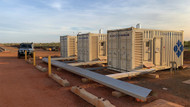Load Management for Generators | Your Guide
12th Aug 2022
Standby and backup generators are a necessity to provide reliable power to any residential or commercial space, or large-scale facility in the event of a power outage. However, without effective load management it can pave the way to severe worksite disruption and potential safety hazards to workers and the electrical load.
Let’s dive into what load management is, what are its benefits and why it’s critical to your generator maintenance.
What is Load Management?
Generators are designed to provide stable power to equipment, worksites and other items, but trying to draw too much power from it can risk overloading it. To combat this, load management helps prevent overloading by giving the user the control to manage the amount of power is being distributed.
Usually, this process is facilitated by an automatic transfer switch (ATS). The user will operate a controller paired with ATS and an external relay to switch the load on or off. The user is then able to allocate power to certain utilities or equipment if needed, also known as priority loading.
The act of balancing power supply between the generator and the load is highly recommended to prevent overloading.
What is Priority Loading?
Priority loading is the act of controlling the allocation of power supply towards specific equipment, machinery or utilities. To accomplish this, your generator will essentially take away or “shed” power from lower priority items in order to guarantee high priority items can continue to run in the case of an outage. This may include critical healthcare support equipment, computers, temperature-controlled facilities.
What are the Benefits of Load Management?
There are four main benefits of effective load management:
- Priority systems can run without interference
- Prevents overloading or overdrawing power
- Improves power quality
- Aids generator synchronisation and paralleling
Priority Systems Can Run Without Disruption
In the case of an outage, you need a guarantee that priority equipment will continue to operate without fail or disruption. Effective load management means that the facility, business or worksite primary and priority equipment can function without fail.
It Prevents Overloading
If power reaches its maximum capacity, the generator will begin to draw back on the power load based on any essential needs. Without this function, the generator will simply shut down - restricting any power output at all.
It Will Improve Power Quality Using Load Banks
Load management also improves the quality of the power when using a load bank. When a generator is outputting a low load, the load bank can kick in to optimise generator operation. On the other hand, it can also provide load relief when a single generator connects to an electrical bus with risk of overloading. Load management allows you to add loads intermittently, allowing the generator to recover in terms of voltage and frequency.
It Helps with Generator Synchronisation
Load management can be essential when synchronising generators. For example, if one generator is taken offline for servicing, maintenance or faults, load management activates the remaining generator to only focus on higher loads. This disconnects any lower loads to provide strong power to where it is needed most.
Need a Power Solution? Get Expert Advice.
With years of experience servicing the mining, construction industries, Blue Diamond Machinery has the equipment you need and can rely on. We not only offer expert advice and industry-leading warranties, we provide an all-encompassing solution. We will customise and install your power solution to your specific power demand requirements, wherever you are. Get in touch with our team today.



